IN TODAY’S EFFICIENT, RATIONALIST, COST-CONSCIOUS architecture culture, squishy, unquantifiable qualities like enchantment are off the drafting table — exiled, beyond the grid, outside the design equation. But in museum design, ineffable qualities that mystify a museum are probably the single most important factor in signaling that the building brackets an out-of-the-ordinary precinct, one that promises special objects and a special experience inside. Architecture as warm visual bath introduces visitors into an immersive experience that preconditions the way they will see the Kiefers and the Pollocks beyond. Enchantment at the front door heightens anticipation. It opens pores.
There is, of course, the Calvinist alternative: museums as Minimalist white warehouses that offer a more blunt, frontal encounter with works of art that stand alone in cool, uninflected Newtonian space. But Frank Gehry, whose Louis Vuitton Foundation museum and cultural center just opened last month, subscribes instead to what might be called architectural Catholicism. Historically, the architects of cathedrals have always used the powers of a subjective and sometimes sumptuous architecture to condition worshippers to the messages delivered inside. By the time they kneel in a pew, the environment has already persuaded them through their awakened senses to believe.
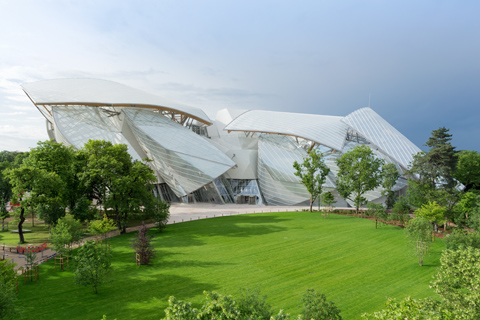 The Fondation Louis Vuitton © Iwan Baan
The Fondation Louis Vuitton © Iwan Baan
Even by Gehry’s elevated standards, no contemporary museum anywhere is more enchanting than the Louis Vuitton Foundation, inaugurated two weeks after the opening of a major retrospective of his work at the Pompidou Center. Equipped with as many glass sails as a three-master, all billowing cubistically in contradictory directions, the building lists to starboard while leaning fore, its prow sailing over a stepped cascade of lapping water. The museum seems to glide within the surrounding canopy of trees in the park, its upper sails piercing the tree line.
You are not on LSD. All sail and no boat, it’s a vision, one that provoked a perfectly sober, gainfully employed psychologist seeing the building for the first time to respond: “I nearly wept in awe. Amazed by how soft, alive and enfolding it is.”
A taxi driver pulling up on opening day put it succinctly: “It’s a new style. It changes things. It’s beautiful.”
The building puts Gehry back on center architectural stage, though it is not sure that the 85-year-old architect was ever off.
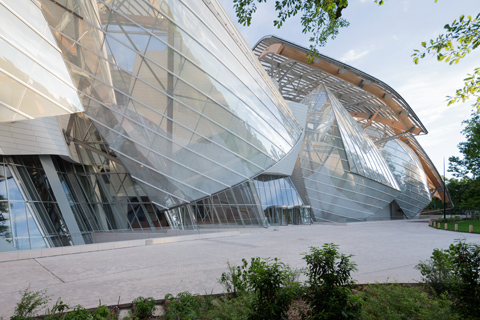 The Fondation Louis Vuitton © Iwan Baan
The Fondation Louis Vuitton © Iwan Baan
He seems to have captured Paris in a perfect Gehry storm with the inauguration of the building in the Bois de Boulogne and the Pompidou career retrospective. Anyone bouleversé by the building can understand the thinking behind the monument by visiting the Pompidou, where the brilliant curator Frédéric Migayrou mounted an idea-based show that explains the roots and evolution of Gehry’s vision.
With its public opening, the museum immediately earned a place in French architectural history right up there with other beautiful, technologically innovative glass structures, including the 13th-century gothic Sainte-Chapelle on Île de la Cité, entirely walled in stained glass, and the 19th-century Grand Palais, a Beaux-Arts exhibition hall with vaulted glass roofs that recalls the monumental spaces of Rome’s great public baths. All were built at a time of new intersections of art and breaking technologies.
Like a classical building ornamented with columns, or a Victorian one with decorative patterns, colors, and materials, Vuitton leads with its facades. Much as Charles Garnier encrusted the Beaux-Arts Opéra with polychromatic marbles, Gehry veils his building in diaphanous glass sheets. But unlike Garnier’s planimetric building, with facades that are basically paintings in marble on two-dimensional surfaces, Gehry’s facade is omnidirectional and three-dimensional, with 12 glass sails attached to the core of the building, to what he calls the “iceberg.” The sails have no functional purpose.
Thus Gehry violates one of the basic commandments of Modernism: Thou Shalt Not Decorate. He does decorate, without holding back, and makes no apologies. He has reversed the usual architectural hierarchy and made the nonessential fundamental. The sails are a poetic necessity with a fragility that responds to its location in a wooded park next to a children’s garden.
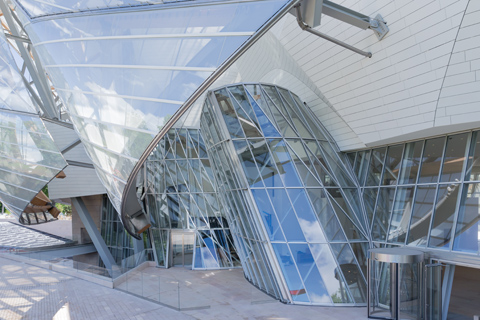 The Fondation Louis Vuitton © Iwan Baan
The Fondation Louis Vuitton © Iwan Baan
His attention to the exterior does not mean that Gehry has neglected the interior, which is much more developed than other Gehry buildings, which have often been criticized for being merely “wrapped.” Visitors enter under one of the Vuitton’s sails into a light, airy, soaring glass hall that bisects the building, affording a view out the back to a riding corral and the Jardin d’Acclimatation, a children’s park that was influential in Gehry’s thinking. Chandeliers in the shape of fish swim in a school inside a tall hall of glass, as though in a fishbowl, above the tables of a restaurant looking onto the back garden adjoining the park.
As meticulously crafted as any Vuitton handbag, a set of glass doors framed in brushed stainless steel leads left to a staircase at the front, and another set leads to escalators at the back, on either side of galleries that start in the basement and continue on the first and second floors. Rather than embarking on the usual death march through a museum down enfilades of rooms, or along a prescribed circulation path, visitors embark on an episodic journey through non-repetitive spaces that introduce them into the galleries one at a time. Circulation is not the generator of the organization, as it was at the height of Modernist ideology, but is fitted into the interstitial spaces between galleries, which are themselves (dis)ordered like houses in a medieval village. Experience rather than geometry rules as visitors discover their way through the building. Again, contrary to all the usual museum rules, visitors poke around, finding their way. All the galleries in the three-story building are of different sizes and shapes, left loosely packed rather than tightly boxed.
Above the galleries, the back escalators and the angular staircase (which projects outside the body of the building) lead to multilevel roof terraces that form a hillside of limestone-paved meadows, all under glass sails supported on a forest of angled steel struts and glulam beams spoking out from the building: the structure resembles the limbs of centenarian trees. With his roofscape, Gehry has, in his way, satisfied environmentalists worried about losing park space by recovering whatever ground was originally occupied by the bowling alley that previously stood here. Public outdoor space, along with hiking trails through a new hilly topography, is displaced to the roof. The limestone floors and white concrete wall panels are tightly set in staggered patterns that give all surfaces a sense of movement. The graphic and sculptural motion of the building propels visitors to move within the perceptually turning spaces. You keep on exploring, the long vistas alternating with intimate crooks of space.
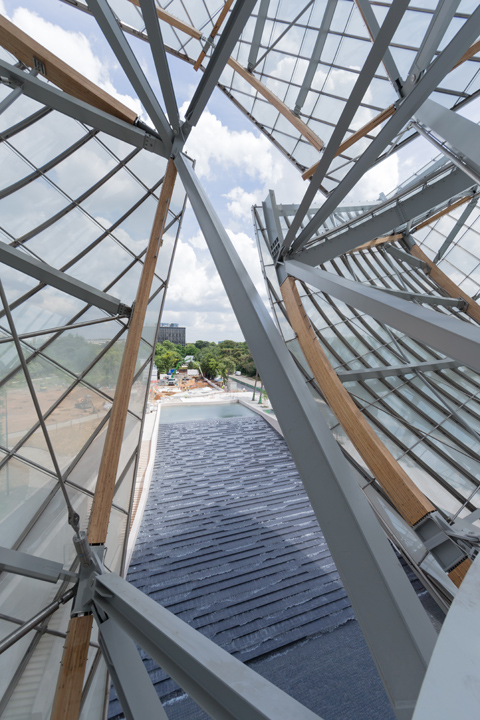 The Fondation Louis Vuitton © Iwan Baan
The Fondation Louis Vuitton © Iwan Baan
The grandeur of the wood and steel superstructure provokes the same emotions inspired by a sequoia forest, or the base of a dam, or the prow of an ocean liner, with that sense of amplitude that creates sensations of awe: visitors are in a wonderland at least as evocative as the fairy-tale structures in the children’s park, though this wonderland is powerful rather than tender. Gehry uses the billowing glass forms to shape space, and the yin/yang of Gehry’s space/form provokes a strong emotional response through the evocative power of its buoyant visual poetry. The building is not just retinal and tactile but emotive, the result of an evocative language that amounts to a visual text, one that speaks to the eye and body without words. You feel the building.
Here above the tree line, the terraces — with episodic paths between shifting terraces — offer views in one direction toward the bland towers at La Défense, best appreciated as a distant skyline, and, in the other, to the Eiffel Tower. From here, the Vuitton structure and the Eiffel Tower seem to speak in a direct crosstown conversation. Gehry’s angled, every-which-way beams, which pivot on massive but elegantly engineered steel knuckles, comment on, and deconstruct, Gustave Eiffel’s symmetrical steel tower. For the 1889 World’s Fair, the Exposition Universelle, Eiffel designed an unprecedented new structure from a relatively new material, but in shapes that perpetuated classical forms, including triumphal arches at the base, and the overall notion of an obelisk. Gehry’s fractal shapes, enabled by the computer, dismantle the unity of a building like the tower and recall instead the nonlinear natural shapes of the surrounding trees and passing clouds — what chaosticians have called “nature’s geometry.” More than any other structure in the park, Vuitton belongs to the forest and sky. For all its virtuoso engineering, or rather because of it, it looks “natural.”
The new museum, built for the Louis Vuitton Foundation and its owner Bernard Arnault, will host temporary shows and house works from both Arnault’s and the Foundation’s collections in its galleries. With two stories above ground, and one below, set within an excavated hollow and bordered by a pool, the 126,000-square-foot building cost more than $135 million. (The Vuitton folks will not say how much more.)
The museum stands on the Avenue du Mahatma Gandhi at the northern edge of the Bois de Boulogne, next to the storied Jardin d’Acclimatation, with its Grimm-style structures and rides. The Foundation is a grown-up version of the fantasy, but without quaintness and nostalgia. Gehry has said that he was responding to the charming fairy-tale structures, which recalled the era of Proust’s Paris, and to the park. His patron, Mr. Arnault, wanted a project that would fit into the wooded and Romantically landscaped grounds. Patron and architect both felt that the tradition of glass pavilions and conservatories in parks was appropriate precedent for the new glass structure.
Arnault reportedly contacted the Los Angeles architect after seeing his Guggenheim in Bilbao, Spain. Gehry’s design for that museum, a game-changing structure whose flowing, piscine forms, clad in titanium, reshaped a derelict waterfront in a fading steel town. Because of the building and its collections, Bilbao became an international cultural destination, and produced the so-called “Bilbao Effect.” Many cities around the world commissioned comparable buildings they hoped would jump-start urban revitalization and establish the cities as destinations on the international cultural map — Milwaukee, Valencia, Oslo, Baku, Rome, and numerous first- and second-tier Chinese cities, including Beijing and Guangzhou.
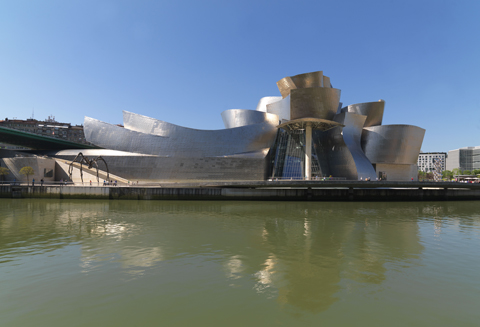 Guggenheim Museum Bilbao. Photo : Philippe Migeat, Centre Pompidou
Guggenheim Museum Bilbao. Photo : Philippe Migeat, Centre Pompidou
But one peculiar, little-noted consequence of the Bilbao Effect is that it has produced just the opposite effect on Gehry’s career: for whatever reason, very few cities hired him to design their museums. The Guggenheim hardly bore any Gehry issue. Perhaps city fathers and mothers feared the architect would only replicate the Guggenheim in Bilbao, and that their museums would suffer from accusations of me-too-ism. Avoiding Gehry for fear his exuberant forms might exceed the budget appear unfounded since Gehry built Bilbao to budget: cost overruns were apparently not the issue given his track record.
In the United States, Italian architect Renzo Piano has instead designed about a dozen museums since the construction of Bilbao, all of them inoffensive and mild-mannered, and only a few memorable.
Arnault proved the exception to the trend of sidestepping Gehry. He brought Gehry to France to see the site and introduce the project. Gehry set about designing a building that builds on the Bilbao precedent and supersedes that remarkable structure in both vision and technology. With Arnault, Gehry — like Michelangelo — had only one pope to please, a strong client personally interested and invested in the result.
¤
The encyclopedic retrospective at the Pompidou Center, which takes Gehry’s career from early residential projects of the 1960s through Vuitton, makes the case that the vision now floating so serenely through the Bois de Boulogne is the result of decades of incremental invention, achieved project by project, insight by insight, initially on small Los Angeles projects.
Migayrou’s show dispenses with the Romantic notion of the architect as an artistic genius visited by some sort of divine afflatus, in favor of a researcher who steadily isolated issues that yielded small breakthroughs along with the bigger eureka moments. Not all Gehry’s projects are shown, mainly those that contributed a strong idea on which he would build the next strong idea.
The DNA of the first projects lasts through Vuitton, which ends this show (and continues in another monographic show on Vuitton alone on the ground floor of the Foundation). Through the graduated suite of projects, we see that Vuitton is a summary structure — and that it did not come from nowhere: it was not an arbitrary whim on a Thursday morning. We see how Gehry evolved his architectural language during a hard-won formation that built on previous insights.
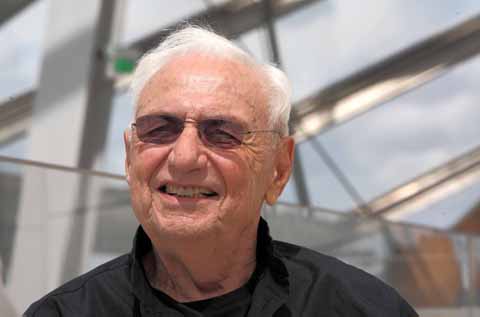 Frank Gehry. Photo: Philippe Migeat, Centre Pompidou
Frank Gehry. Photo: Philippe Migeat, Centre Pompidou
Gehry basically has run a design lab. Exploration of this intensity and duration is rare among architects, for whom office pressures, financial constraints, and client directives limit creative research. Most often innovation comes from magazines rather than core practice. Gehry practiced architecture like the artists he befriended, developing an intuitive hunch until he realized its potential, then pursuing another, storing all in his quiver to use as necessary in following projects. Migayrou bases the narrative of this edifying idea-based show largely on Gehry’s drawings and sketch models, the scene of his investigations and invention.
The career of the Gehry we know started in the 1960s, after being employed in large commercial offices. Once on his own, he experimented with small-scale wood-frame structures built for friends who were often artists or collectors, all the while working on breadwinning jobs like parking garages. His artist friends in and around Venice, California, became a receptive clientele. Estranged from LA’s architectural establishment, he was practicing in a supportive milieu. Arguably the artists were interested in the same issues because their questions became Gehry’s questions. A graduate of the University of Southern California architecture school, Gehry went to school again in Venice, absorbing ideas that distanced him from commercial practice, the Wilshire mindset, and even architectural traditions. He largely abandoned the drafting table and its tools, the parallel rule and T-square, modeling buildings sculpturally by hand in physical models. The plan became no longer the generator but the consequence. The move away from the drafting table and its gridded logic was liberative.
In drawings for the office interiors of Mid-Atlantic Toyota in Maryland, done for Los Angeles collector Frederick Weisman, Gehry slashes the plan of the interior with diagonal overhead beams, which strain and test the orthogonal world enclosed by the big-box warehouse. Gehry inclines the tops of nonstructural interior walls in a landscape of forced perspectives that imply contradictory spaces similar to the anamorphic paintings being done by Al Held at the time. Gehry was building Held’s illusionistic spaces, creating optical machines that made visitors see space differently: vision is a construct. He was building lenses that scrambled the rational space we have inherited from the Renaissance.
In a series of houses and buildings, Gehry pursues perceptual issues that mystify his designs, turning them into spatial conundrums. In a brilliant and probing series, starting with the Davis Studio and the Wagner House, both in Malibu, and the Gemini G.E.L. Gallery on Melrose, he designs multi-perspectival forms that confound any sense of a Renaissance whole, all the while using drawing techniques from the Renaissance. Playing with vision, using crossed, reversed, and forced perspectives, he achieves strange, otherworldly effects that break up traditional naturalism and realism. In the unbuilt but seminal Wagner House, he combines forced perspective with isometric drawing, another kind of projective drawing technique (often used by traditional Japanese and Chinese painters to show depth in space). He achieves in real space the illusionist effects of an Escher drawing.
Unlike other architects of the time, even collector architects like Philip Johnson, Gehry has imported ideas like anamorphosis (distorted projections that seem normal from one point of view) from art directly into architecture, spatializing them, making them concrete and three-dimensional. In his own Santa Monica house, finished in 1979, he effectively builds an outdoor gallery installation on a corner suburban lot, collaging ideas he has gleaned from Los Angeles artists Larry Bell, Ed Moses, and Robert Irwin, among others, in a suburban combine of street materials. It was his shot across the bow of the profession, his shift in paradigm.
Without ever leaving behind his breakthroughs, he moves on to others in houses that are a hatchery of ideas. In another series, Gehry breaks the program into its one-room constituent parts, proposing buildings as villages of forms, each room distinguished from the others. Again, there is no sense of a unitary whole. In a house designed for a filmmaker in Santa Monica, Gehry separated each of the one-room structures so that they were stand-alone buildings in a disaggregation of structures. He differentiated each from the others by diversifying the forms, colors, and materials. With rooms scattered across the parcel, he renders the spaces in between positive rather than residual, unlike the standard house plopped on a parcel with front and back yards shaped by default.
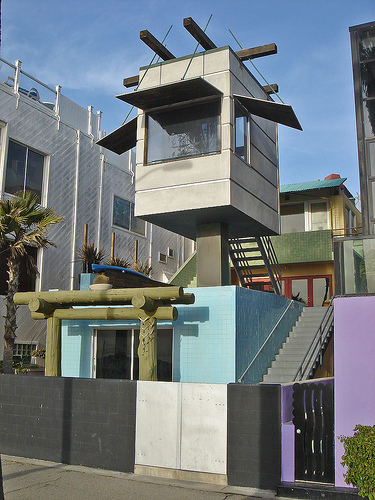 Norton Beach Residence
Norton Beach Residence
In the Norton Residence, a shaggy beachfront house with a writing studio shaped like a lifeguard tower in front, Gehry purposely drew on the messy vitality of the surrounding streets of scruffy Venice to build a cacophony of forms that acknowledged its dystopian reality. This was not an ideal building in a utopian setting, but a response to the gritty, grotty alleys of Venice (before gentrification). He was not looking at the front facades in the beach town but at the side yards and in-between spaces, to achieve another suburban combine.
Migayrou has said that rather than conceiving a show that displays Gehry’s buildings as a series of objects, he constructed a project-based portfolio of Gehry’s ideas. One original contribution that the curator has made to an understanding of Gehry’s work is to include a section on the architect’s urban designs. Exhibited are projects dating from the 1950s, during his time with Gruen Associates. The curator also displays urban block plans he did in 1961 working in Paris in the atelier of Robert Auzelle. One of the drawings shows blocks of buildings jostled off the orthogonal, as though shaken and energized by a force. It is hard to reconstruct 50 years later how original and iconoclastic this proposition must have been at the time, especially when we see the deadening apartment blocks beyond Paris’s Périphérique.
Exposed to his work as an urban planner, we can see that the sensibility of a planner continues to inform most of his projects, including Vuitton, in which the interior seems ordered into a small town of galleries, with walkways in the interstices of the interior buildings: it’s both Venice, California, and Paris’s episodic medieval streets.
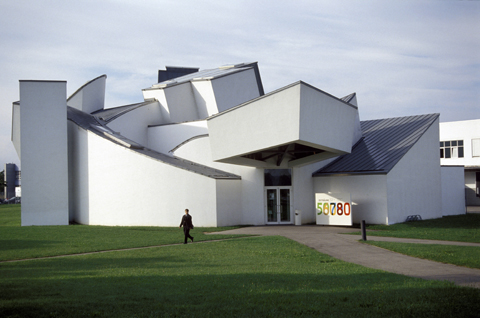 Vitra International Furniture Manufacturing Facility and Design Museum.
Vitra International Furniture Manufacturing Facility and Design Museum.
Photo : Thomas Mayer
Gehry then performs self-surgery on his experiments, and starts to recombine the parts of his separate structures into new fusions. In the seminal 1989 Vitra Design Museum outside Basel, he attaches corkscrew staircases onto interpenetrating cubes that appear tossed. Momentously, the design introduces curving forms and the notion of liquidity into his oeuvre, which will play an increasing role in later designs.
The very ambitious Lewis House, an unbuilt project, served as a petri dish of ideas for about five years. For a suburban site outside Cleveland, Ohio, Gehry created a sprawling building of disparate forms fused in paratactic relationships, in which inverted cones, folded drapes, cresting waves, among other shapes, were abruptly juxtaposed without coordination or subordination — without ingratiating transitions. Gehry was not playing the host introducing his guests, but just throwing them together in the same room, to sink or swim. The house, with its agglomeration of forms shaped in contradistinction to one another, established itself as one of the design models to which he would frequently return. By this time Gehry has discovered that with the right material, the roof can merge into the wall in continuous curves and planes that erase the distinction between the two.
By the mid-1980s, Gehry was proposing three-dimensionally complex forms that were very difficult to document on paper. Gehry started using the computer to design and build piscine shapes with devilishly difficult compound curves, first for the 1987 Fishdance Restaurant in Kobe, Japan, with a carp leaping up by the side of a highway, and then for a giant fish sculpture built for the Barcelona Summer Olympics in 1992. The architect who had relinquished the planimetric designs of the drafting table in favor of complex forms in complex combinations couldn’t return to the drafting table to execute the drawings. He turned to software.
¤
In a slow-motion epiphany strange for an analog architect who liked to handle physical models, the computer enabled Gehry to radically change the architectural game. Migayrou positions the Lewis House as the project that pivots Gehry to the fluid forms that will eventually envelop the later structures, including Disney Concert Hall in Los Angeles, and, later, the Bilbao Guggenheim.
The Lewis house is a hybrid of disparate shapes but with an undulating fabric of forms pouring through the roiling landscape of cones, spirals, and octopi. The fabric, inspired by the clothing on medieval sculpture Gehry saw in Spain, establishes continuity across the building, a valley rippling within the surrounding scrum.
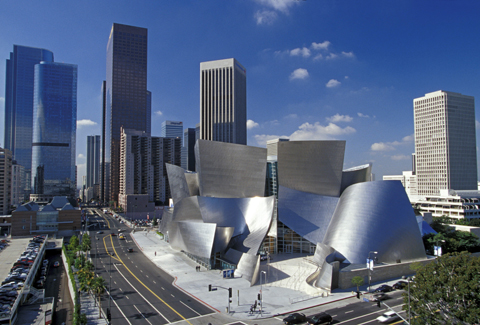 Walt Disney Concert Hall © Gehry Partners, LLP
Walt Disney Concert Hall © Gehry Partners, LLP
The computer proves a smoothing agent that established continuities across his paratactic landscapes, translating them into topographic flows. Disney Hall is scalloped in curves that resemble waves; the curves of the Guggenheim are of longer duration, resembling ribbons. Both buildings establish another model for Gehry’s designs, the waves and ribbons wrapping buildings organized around cubes boxing program demands inside. Unlike his other model, with disparate outside forms molding equivalent spaces inside, Gehry’s “wrapper” buildings have been criticized for the dissociation between flowing outsides and cubic insides. Gehry has justified the position by saying that outside and inside can be independent, that consistency is unnecessary, a Modernist hang-up and holdover.
Perhaps.
While Migayrou consistently takes the high road in presenting Gehry’s evolutionary progression of ideas, he does so with prejudice. He plays to Gehry’s strength by showing the gestural sketches that establish the general body language of the buildings, and then the working models, which elaborate the sketches. Most of the exhibits show that Gehry views the building from the outside, a product of Gehry’s own design process, which itself is a product of an attitude inherited from his artist colleagues, who sculpted their art, and even their loft environments, by hand without drafting tools.
Unlike Le Corbusier, for whom the plan was the generator, the elevation became the generator for Gehry: he conceives the building by visualizing it from the outside. Gehry could actually do his initial gestural sketches in plan and section as well as elevation, but he doesn’t: at least there is no evidence in the show. We never see what the spaces of the Lewis house would be inside under the waving carapace, especially as it bumps into the truncated pyramid and other forms. There is no indication of what happens in the ground plane, or how the spaces are divided within volumes agitated by ceilings that curve into walls. The lack of evidence implies the interiors are underdeveloped.
Gehry studies enclosure more than space, plan, or section. The show is a historical view of his progress but it does not critique the process as he builds his vision.
¤
That all changes at Vuitton, whose interior is one of Gehry’s most developed and successful. In a well-choreographed inter-institutional collaboration, Migayrou effectively passes the baton of his encyclopedic show at the Pompidou to the monographic show on the first floor of Vuitton, acting as the intellectual hyphen between the two institutions. The show of Vuitton at Vuitton explains the evolution of Gehry’s design through a progression of models that essentially builds the museum before your very eyes. It’s a close-up, time-lapse movie of the design.
Yes, of course there are Gehry’s “seminal sketches” of the building, which change over time. Gehry is not an architect who thinks that the first sketch is fundamental and unchangeably true. He ruminates over a long period, masticating ideas, receptive to input from many sources, including the client, in an open, nonlinear process that absorbs and even welcomes change and contradiction. The surprisingly pragmatic process yields complexity rather than pure forms and singular concepts. The complexity enriches the building and finally the experience.
With Vuitton, Gehry does not simply organize his interiors with blocks representing an optimal arrangement of the 11 galleries. He designs the organization itself, positioning and spatializing the pieces, and tries many configurations.
His client discussions included the Foundation’s artistic director, Suzanne Pagé, who gave Gehry and his design crew, Edwin Chan and Laurence Tighe, very specific requirements for the types of galleries. In a sequence of study models that might be called sketches, he organizes them in various configurations: he lines the galleries up in bars, he stacks them, he separates them, he throws them around like dice. What he does not do is juggle the galleries vertically to achieve stepped sections that might yield terraced, more continuous interiors (as in the terraced galleries at the Walker Art Center in Minneapolis, or as in his own roof terraces atop Vuitton). Some of the models recall the site plan of the filmmaker’s house in Santa Monica, where each separate volume formed another room in the house dispersed on the site.
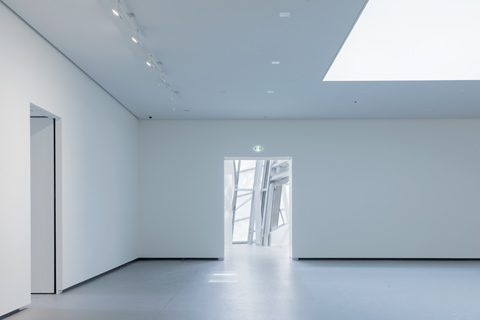 The Fondation Louis Vuitton © Iwan Baan
The Fondation Louis Vuitton © Iwan Baan
He settles on a loosely assembled set of galleries on three floors, each with space between that allow cross views out, as well as the penetration of natural light, between the galleries. The downside of the strategy is that there is little connection between the galleries, and so little possibility of curatorial continuities between shows in each: each tub sits on its own bottom. Ms. Pagé, however, did not require inter-gallery connection. According to Mr. Chan, she wanted the separation.
Only after he finds the relationship does Gehry drape the galleries with handmade circulation routes, pinned in place on the models like saddlebags. Episodic experience is the result, since the corridors and stairs constitute a virtual hike to, through, and among the galleries.
Gehry has broken a cardinal rule of museum design that the route should be clear and self-guiding. People rather poke about this museum, encountering galleries, bumping into artworks placed in the interstices and leftover spaces, which the architects call “chapels.” The exploration seems to pique everyone’s curiosity as they discover pockets of space between the cavernous galleries. The museum is small enough that the inefficiency of doubling back to retrace the path isn’t bothersome. The experience also occurs within a building whose openness to the exterior allows light and shadow to play on and through the forms, the sun turning the building into a gyroscopic sundial.
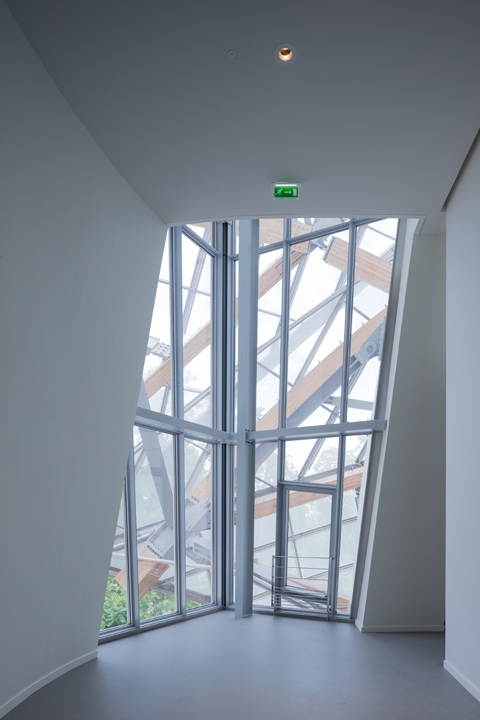 The Fondation Louis Vuitton © Iwan Baan
The Fondation Louis Vuitton © Iwan Baan
The sails seem to move; the staggered floor and wall tiles seem to move; the sun sets it all into motion, prompting the visitor, also, to move.
Gehry has a long memory for his breakthroughs small and large, and the incremental accomplishments from the Pompidou show appear at Vuitton, as at a reunion. Walt Disney Concert Hall was inspired by sailing; Gehry said that when sailing downwind, he liked to stand in the space between the mast and the billowing spinnaker. The sails from Disney reappear big time in Paris.
One of the most important recollections is from the 900-seat Fisher Center for the Performing Arts at Bard College, built in 2003, in which he keeps the ribbons that enfold the black box concert hall distant from the interior cube, forming an in-between space that serves as the public gathering area. At Bard, the space was somewhat happenstantial, simply what was leftover between the box and the exterior ribbons. At Vuitton, the in-between space is more intentional, a place in itself.
The result is that Vuitton is nested like a Russian doll, from the billowing curves outside, to the weather membrane that encloses the circulation arteries, which themselves wrap the galleries. The building is spatially layered with an interior as complex and developed as the exterior.
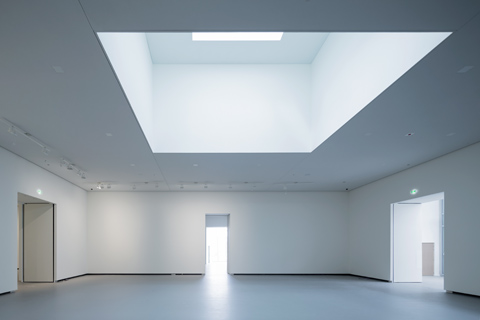 The Fondation Louis Vuitton © Iwan Baan
The Fondation Louis Vuitton © Iwan Baan
Within the layers of this architectural onion, most surprising are the galleries, which are generously sized, designed for the large-scale contemporary art that forms the core of the collections. Although the galleries are jostled relative to each other, each is a regular volume of vertical walls and right-angled corners, disarmingly conventional given the context outside. As big, white, clean spaces, variants of cubes, they are eminently suitable for hanging art. Their calm provides respite from Gehry’s storm.
Gehry takes the lid off each cube, shaping chimneys of space that reach up to natural light filtered through skylights. Gehry is one of the few architects specializing in museums who knows how to capture light and channel it to lower floors. The vertical volumes interrupting the horizontal flow of his galleries at the Guggenheim catch and transmit light to galleries one and two stories below. He does the same in Paris.
¤
The building has been a triumph even for the very picky, still chauvinistic French, and Gehry was the toast of Paris, feted at a dinner attended by no less than the President of the Republic, François Hollande, who waxed poetic about the building’s poetry, calling it a “cathedral of light.” But the unsung hero in this generous, big-hearted American vision is actually French, and Gehry is the first to credit the software program CATIA, produced by Dassault, the aeronautical company, which has been indispensable to Gehry for about 20 years.
With the Vuitton project, the process marked the first time for Gehry that all the different trades — involving hundreds of different people by Gehry’s count — were managed and coordinated at the same time on the same screen. Says Gehry:
It was the first time that we coordinated all the trades by computer management. The program coordinated about 240 different people talking to each other in all the different languages of form, material, trades and detailing, and even in different languages. Yes, that kept the costs down. It was nice to use CATIA in France. They deserve a plug.
Gehry has used CATIA since Disney Hall to transcribe his models onto screens that then translate the three-dimensional modeling into construction documents. The computer-enabled work is especially revelatory in Paris, the capital that delivered Enlightenment rationalism to the world, and especially revelatory in the Pompidou Center, an oil-refinery of a building that pushed industrial logic to a monumental extreme. The fluid, apparently spontaneous forms of Vuitton, and the jostled planning inside, offer moments that verge on a wildness unusual in the highly regulated, if not over-controlled, society and city that developed the metric system. The irrationality of apparent disorder stands out within a culture of rationality.
As the Mid-Atlantic Toyota plans show, Gehry from the beginning fights to break the grip that Descartes has had on the architectural imagination since the mathematician established the three-dimensional x, y, z grid that has disciplined and caged the mind of the profession in the centuries since. While the Pompidou Center, with its exposed steel structure and environmental ducts, is a late architectural expression of the Machine Age, Gehry’s buildings inaugurated the new digital age in architecture, and represent a radical shift in paradigm that ironically circles back to French rationalism, just in digital form.
The complexity that we see at Vuitton is practicable only because of the exacting precisions enabled by digital computation in architecture. The computer has given science the ability to understand nonlinear phenomena like the clouds and trees that form much of Vuitton’s context, and it has likewise given Gehry the ability to design a nonlinear, post-Cartesian building that takes architectural math to another level. Where better than Paris? And who better than a Los Angeles architect inspired by one of the world’s least structured, most deconstructed cities?
The building is a magnificent rebound of American and California culture, with its intimations of openness, iconoclasm, and wildness, on Europe’s seat of reason.
¤
Inevitably such a brilliant building dares critics to find serious fault. Inexplicably, the Observer architecture critic, Rowan Moore, who wrote in his excellent recent book, Why We Build, that enchantment in a building is as essential as bread, doesn’t accept the enchantment of the sails billowing at Vuitton. He faults the building for being a compounded brand, LVMH using Gehry as a name, conflating the brand with art to enhance its status as a company that sells luxury.
Presumably Gehry should not have accepted the commission, or at least not allowed his art to be used commercially. However, removing the sails, as Moore advocates, would be tantamount to redacting all adjectives and adverbs from a poet like Wordsworth: the poems would no longer work; they would not be poetry. The inessential, sometimes, is necessary.
In the same book, Moore says that some architects have been “intimate” with power, but know how to shake hands with power and escape with their integrity. Many people, especially the French, do not like Arnault for his hostile takeovers of luxury brands, long quietly owned by established families. Louis XIV was probably not such a nice guy either, especially from the point of view of people on the receiving end of his armies. But Versailles stands today as a total work of art, a Gesamtkunstwerk, long after it has shed the motives of architectural glory at the service of kingly power. In his time the Sun King used architecture as a political tool. But today Versailles remains a remarkable artifact of its time, a document of the search for baroque space, down to the details, like foliage turning in deep curves in its carpets and the twisting branches of sconces holding candles. As a tourist draw, it adds much revenue to the French economy today, and it still burnishes France’s image as a seat of culture.
Arnault will certainly capitalize on Gehry’s designs through PR rub-off. Vuitton shops throughout Paris already have sails decorating the stores’ windows, honoring the building and conflating the Gehry signature with the Vuitton brand. (The Gehry office designed the sails in the windows.) For Gehry, however, despite the commercialism, the commission allowed him to evolve the research we see in both shows to the next stage, in one of the most complete and daring buildings of his career. And the museum will take its place among a very small handful of other contemporary monuments in Paris that both evoke and transcend their time.
Yes, Gehry was designing for and with Arnault. But he was also effectively designing for architecture, for what the building simply wanted to be in its total context. There is every sign that the building will enter France’s pantheon of great buildings, and long outlast the power structure that enabled its creation. It already enhances the park and adds to Paris’s cultural life, and in 55 years the building reverts to public ownership: it has been erected on public land, and the LV insignia now worn on its facade like a broach will vanish.
From the point of view of contemporary architecture history, Vuitton comes at a time when there has been increasing agitation against what has been called “spectacle” buildings, in favor of less formal, more modest efforts with a social agenda, usually encased in a box. Usually the design police accuse such buildings of “vacant formalism.”
No less than Gehry’s fellow Deconstructivist Rem Koolhaas, reacting to the meaningless architectural overreach of buildings on the Abu Dhabi skyline, has spoken about the death of architecture. He enacted his burial of “Architecture” at the recent, about-to-close (on November 23) Venice Biennale, “Fundamentals,” where he took the position of a fundamentalist, exhibiting building parts — windows, ramps, cladding — rather than exhibiting exceptional buildings done by his competitors and equals. The galleries constituted visual catalogs that displayed considerable research, but without evaluation. Just the constructive facts. Koolhaas takes the Calvinist rather than Catholic position: banality in the name of simplicity was the point, and a virtue. The poetic text, enchantment, was conspicuous by its absence, and never considered because the ineffable is not material.
The death of architecture is not a new theme: it has parallels in other fields. The death of the novel has been announced with some regularity for decades. And in a revealing coincidence, a concomitant show at the Pompidou Center, “Marcel Duchamp. La peinture, même,” exhibits how the French artist staged the death of painting in a series of works that killed painting off, and led his own painting to a dead end. In many ways, from his readymades to his marzipan sculpture, Duchamp challenges the mimetic tradition in painting, discrediting even its “retinal” qualities by supplanting them with texts. His forays into “anti-art” are forerunners of conceptual art. He eventually seals himself off hermetically in a world of his own for two decades, working on his last strangely puzzling and opaque masterpiece, Étant donnés.
The Duchamp exhibition shows that there are multiple contexts around a work of art or architecture, including an invisible world of ideas. Parallels between Duchamp and Gehry are made clear in the simultaneous shows. Duchamp challenged the realism and naturalism of representational art, and in his medium, Gehry did the same, as he broke down perspective into anamorphic distortions that undermined the sense of a realistic whole. He further eroded the “naturalistic” presentation of a building by simply breaking it apart, reassembling the parts into new non-wholes, challenging the fundamentals of what makes a window, door, roof, and wall.
He was not dealing with the standard kit of building parts out of a catalog, as Charles Eames did before him, and as Rem Koolhaas advocated in the Venice Biennale. Like Duchamp, Gehry also challenges the retinal dominance of a work of architecture by suffusing it with a poetic textuality that speaks, beyond language, to perception: his intimations of movement challenge the static nature of a building, and their tendencies to visual disequilibrium challenge the statics of engineering, its structure, and speak to the inner ear. Our bodies are more alert in a spirited building like Vuitton.
Unlike Duchamp, however, Gehry’s apparently anti-architectural explorations do not dead-end in hermetic paralysis, or in Koolhaas’s cynical call for banality. Gehry is an iconoclast who breaks precedent, taking the icon apart in order to build another, simply in a different way. The Deconstructivist is a Reconstructivist, and his research and challenge always end by reaffirming the discipline rather than eroding or diminishing it.
Gehry is not a vocal polemicist, but he effectively argues his own case by positing Vuitton as the material evidence of his progressive search. Many of the architects who say that he is wrong to pursue such manifest complexity simply have not constructed offices capable of handling designs that demand the level of Gehry’s sheer skill. Gehry’s constructive feats are possible only in an office that has developed its technological capacities to match the vision. Those are few.
Vuitton is not easy or glib architecture, and part of the effect on the visitor comes from the sheer wonder of how the vision was built. Gehry is one of the very few architects with the virtuosity to handle such intricate invention.
Gehry remains at 85 as central and necessary to the field as he did when the Guggenheim Bilbao was opened, which arguably changed the game for architecture around the world. No doubt the Bilbao Effect will now translate into Paris Envy, and cities everywhere will — or at least should — want to hit the refresh button and hire Gehry to build their own game-changer.
¤
LARB Contributor
A Pulitzer nominee in criticism who trained in architecture at Harvard, Joseph Giovannini has led a career that has spanned three decades and two coasts. He has served as the architecture critic for New York Magazine and the Los Angeles Herald Examiner, and was long a staff writer on design and architecture for The New York Times. On a contractual or freelance basis, he has contributed to many other publications, including The New Yorker, Architectural Record, Architectural Digest, Art in America, Art Forum, Architecture Magazine, Architect Magazine, Industrial Design Magazine, and Interior Design.
A prominent figure in American architecture, he has been an activist critic with a record of discovering emerging talent for major mainstream publications and professional journals. He coined the term Deconstructivism during articles he wrote announcing the movement. Giovannini has written literally thousands of articles for periodicals, and he has also authored numerous essays for books and monographs. As a critic, he has won awards, grants and honors, from the Art World Magazine/Manufacturer’s Hanover Trust for distinguished newspaper architectural criticism, the National Endowment for the Arts, the Graham Foundation, the Los Angeles Chapter of the AIA and the California Council of the AIA.
He has put theory into practice in his own architectural practice. Mr. Giovannini heads Giovannini Associates, which has recently completed the conversion of a large trucking warehouse into a community of lofts in Los Angeles, and a 19th-century commercial building, also into lofts. A bicoastal designer, he is currently working on several apartments in New York and lofts in Los Angeles. His lofts, apartments, galleries and additions have appeared in Architectural Digest, Los Angeles Times Magazine, A + U, Domus, House and Garden, GA Houses, Architekur und Wohnen, Sites, and Interior Design.
He has taught advanced and graduate design studios at Columbia University’s Graduate School of Architecture, UCLA’s Graduate School of Architecture and Urban Planning, the University of Southern California’s School of Architecture, and at the University of Innsbruck. He holds a Master in Architecture from Harvard’s Graduate School of Design. He did his B.A. in English at Yale University, and an M.A in French Language and Literature from Middlebury College for work done at La Sorbonne, Paris.
LARB Staff Recommendations
Response to Sharon Johnston and Mark Lee
Sharon Johnston and Mark Lee defended Zumthor's LACMA plan; not very well, says Joseph Giovannini.
Unpacking the Museum: Renzo Piano’s American Museums and His New Whitney
Piano’s Whitney Museum is open, accessible, energized, urban, and fun.
Did you know LARB is a reader-supported nonprofit?
LARB publishes daily without a paywall as part of our mission to make rigorous, incisive, and engaging writing on every aspect of literature, culture, and the arts freely accessible to the public. Help us continue this work with your tax-deductible donation today!
:quality(75)/https%3A%2F%2Fdev.lareviewofbooks.org%2Fwp-content%2Fuploads%2F2014%2F11%2F2.-Iwan-Baan-for-Fondation-Louis-Vuitton-5073.jpg)